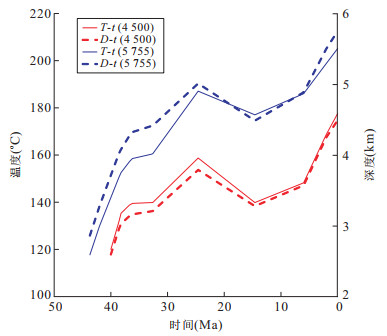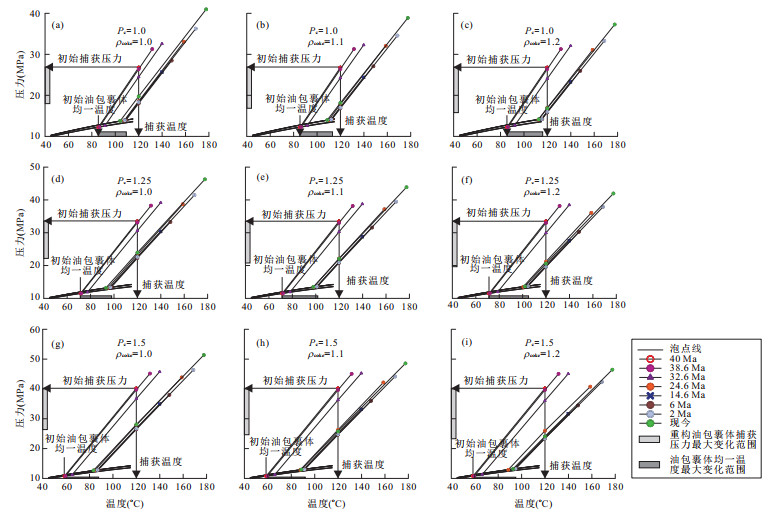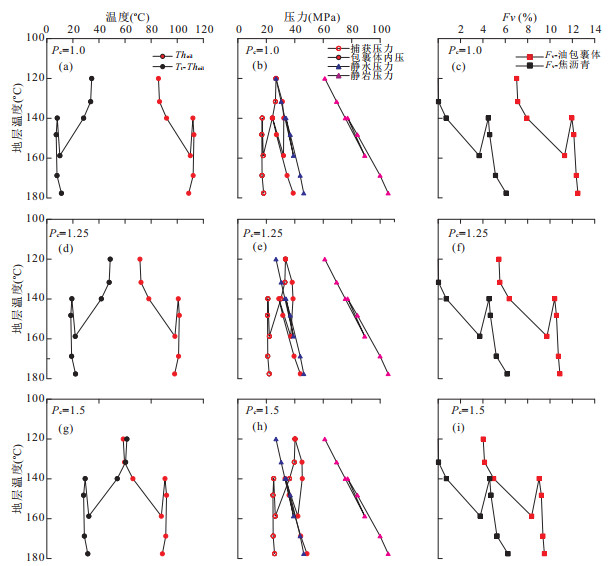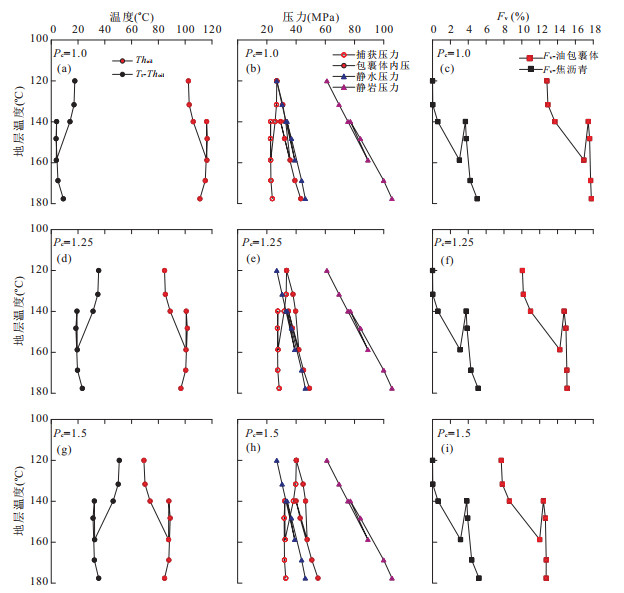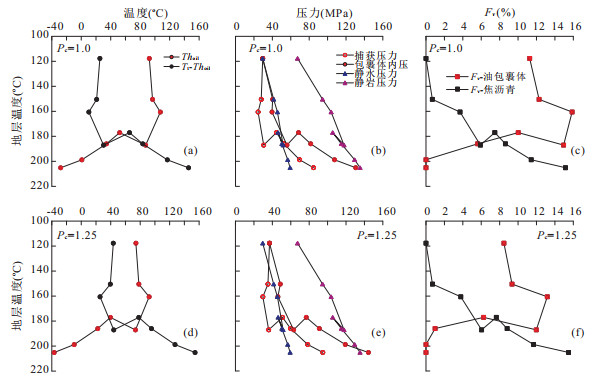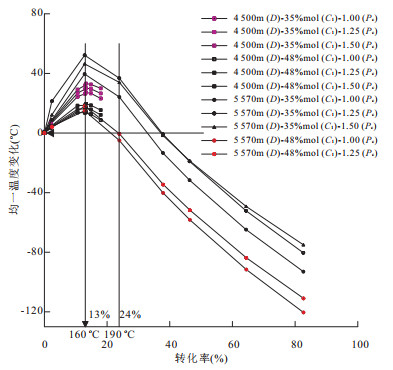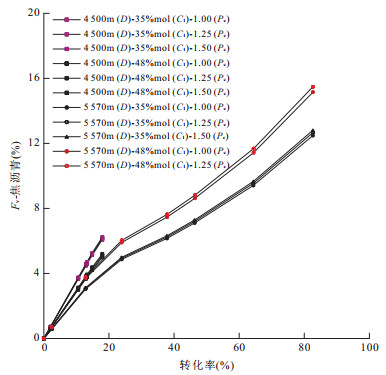Effects of Oil Cracking on Homogenization Temperature and Trapping Pressure of Oil Inclusion and Its Geological Significance
-
摘要: 通过原油裂解动力学和石油包裹体热动力学模拟方法系统阐述了地质条件下原油裂解过程对油包裹体均一温度及捕获压力的影响.结果表明:初始裂解阶段(TR<13%,T<160 ℃),油包裹体均一温度随原油裂解呈增大趋势,捕获压力呈减小趋势;随着裂解程度增大(TR<24%,T<190 ℃),油包裹体均一温度随原油裂解呈减小趋势,捕获压力呈增大趋势,但此阶段油包裹体均一温度仍高于初始捕获时均一温度,捕获压力仍小于初始捕获压力;此后,随着原油裂解程度不断增大,油包裹体均一温度持续减小甚至到负值,捕获压力则持续增大甚至超过静岩压力.封闭条件下低程度的原油裂解(T<160 ℃,TR<13%)只会形成常压或者低压;而较高程度的原油裂解(TR>40%)才会形成超压,甚至超过上覆静岩压力(TR>70%).深部原油裂解气勘探中要特别注意地层温度位于160~190 ℃范围内的常压到低压油气藏,而地层温度高于190 ℃原油裂解气勘探应以找超压-超高压油气藏为主.Abstract: This paper systematically elaborates the effects of oil cracking on homogenization temperature and trapping pressure of oil inclusion using crude oil crack kinetic and petroleum inclusion thermodynamics modeling. The results demonstrate that homogenization temperature shows a trend of increase and the trapping pressure shows a trend of decrease at the initial stage of oil cracking (TR < 13%, T < 160 ℃); with the progressing of oil cracking (TR < 24%, T < 190 ℃), homogenization temperature shows a trend of decrease and the trapping pressure shows a trend of increase, however, the homogenization temperature still exceeds the initial homogenization temperature and the trapping pressure is still below the initial trapping pressure at this stage of oil cracking. After that, the homogenization temperature continues to decrease or even turns negative values in some severe oil cracking processes; at the same time, trapping pressure continues to increase or exceed litho static pressure. In addition, oil cracking only results in normal pressure or under pressure during the initial stage of oil cracking (TR < 13%, T < 160 ℃), while oil cracking will lead to overpressure (TR > 40%) or even exceeding litho static pressure (TR > 70%) during the high level of oil cracking. Therefore, deeply buried reservoirs with pressure systems from under pressure to normal pressure should be paid more attention especially when formation temperature ranges from 160 ℃ to 190 ℃, and oil cracking gas exploration should be focused on the reservoirs with overpressure or ultrahigh pressure when formation temperature is over 190 ℃.
-
Key words:
- fluid /
- inclusion /
- homogenization temperature /
- trapping pressure /
- overpressure /
- oil cracking /
- thermodynamics /
-
/ -
-
图 6 不同捕获压力条件下油包裹体A(表 2)均一温度、内压、气泡充填度以及固体焦沥青体积比随地层温度变化(油包裹体捕获后加热历史为今埋深4 500 m热演化史,捕获温度、深度及时间等见表 4)
Fig. 6. Variation of oil inclusion A (Table 2) homogenization temperature, interior pressure, bubble filling degree and volume percent of solid coke with increasing of formation temperature under different trapping pressures
图 7 不同捕获压力条件下油包裹体B(表 2)均一温度、内压、气泡充填度以及固体焦沥青体积比随地层温度变化(油包裹体捕获后加热历史为今埋深4 500 m热演化史,捕获温度、深度及时间等见表 4)
Fig. 7. Variation of oil inclusion B (Table 2) homogenization temperature, interior pressure, bubble filling degree and volume percent of solid coke with increasing of formation temperature under different trapping pressures
图 8 不同捕获压力条件下油包裹体A(表 2)均一温度、内压、气泡充填度以及固体焦沥青体积比随地层温度变化(油包裹体捕获后加热历史为今埋深5 755 m热演化史,捕获温度、深度及时间等见表 4)
Fig. 8. Variation of oil inclusion A (Table 2) homogenization temperature, interior pressure, bubble filling degree and volume percent of solid coke with increasing of formation temperature under different trapping pressure
图 9 不同捕获压力条件下油包裹体B(表 2)均一温度、内压、气泡充填度以及固体焦沥青体积比随地层温度变化(油包裹体捕获后加热历史为今埋深5 755 m热演化史,捕获温度、深度及时间等见表 4)
Fig. 9. Variation of oil inclusion B (Table 2) homogenization temperature, interior pressure, bubble filling degree and volume percent of solid coke with increasing of formation temperature under different trapping pressure
表 1 用于原油裂解过程模拟的初始油包裹体组分数据
Table 1. The initial composition contents of oil inclusions used for oil cracking process modeling
组分 分子量
(g/mol)油包裹体A 油包裹体B 摩尔分数
(mol%)质量分数
(wt%)摩尔分数
(mol%)质量分数
(wt%)C1 16.00 34.732 3 5.247 47.900 2 9.638 1 C2 30.07 6.502 4 1.846 7.943 4 3.003 8 C3 44.10 6.128 2 2.552 6.031 8 3.345 2 iC4 58.12 1.370 2 0.752 1.232 2 0.900 6 nC4 58.12 3.069 0 1.684 2.760 0 2.017 3 iC5 72.15 2.079 7 1.417 1.724 7 1.564 9 nC5 72.15 3.338 5 2.274 2.768 5 2.512 0 C6 84.00 3.609 1 2.862 2.612 5 2.759 7 C7 96.00 3.889 8 3.526 2.815 7 3.399 3 C8 107.00 3.579 2 3.616 2.543 3 3.422 2 C9 121.00 3.308 1 3.779 2.313 1 3.519 8 C10 134.00 3.066 4 3.879 2.114 0 3.562 4 C11 147.00 2.026 2 2.812 1.379 3 2.549 7 C12 161.00 1.864 1 2.834 1.268 9 2.569 2 C13 175.00 1.714 9 2.834 1.167 4 2.569 2 C14+ 311.95 19.721 9 58.087 13.425 1 52.666 7 表 2 表 1中油包裹体组分组合后各组分含量
Table 2. Composition contents of grouped compositions of oil inclusion in Table 1
组分 油包裹体A 油包裹体B 摩尔分数
(mol%)分子量
(g/mol)质量分数
(wt.%)摩尔分数
(mol%)分子量
(g/mol)质量分数
(wt.%)CO2 0 44.000 0 0 0 44.000 0 0 C1 34.732 3 16.000 0 5.246 8 47.900 2 16.000 0 9.638 1 C2 6.502 4 30.070 0 1.846 1 7.943 4 30.070 0 3.003 8 C3-5 15.985 6 57.500 0 8.678 5 14.517 2 56.637 2 10.339 9 C6-13 SAT 16.344 8 121.000 0 18.672 8 11.430 9 121.000 0 17.394 0 C6-13 ARO 6.713 0 117.845 3 7.469 1 4.783 3 115.664 3 6.957 6 C14+ SAT 11.230 6 299.180 0 31.723 4 7.644 9 299.180 0 28.763 3 C14+ ARO C 0 - 0 0 - 0 C14+ ARO U 4.492 3 299.180 0 12.689 4 3.058 0 299.180 0 11.505 3 C14+ NSO 3.999 0 362.157 9 13.673 9 2.722 2 362.157 9 12.398 0 Precoke 0 - 0 0 - 0 Coke 0 - 0 0 - 0 表 3 油包裹体P-T计算需要的各组分临界参数
Table 3. Critical parameters of compositions in Table 2 for oil inclusion P-T calculation
组分 临界温度Tc(K) 临界压力Pc(MPa) 偏心因子ω CO2 304.19 7.382 0.227 6 C1 190.56 4.599 0.011 5 C2 305.32 4.872 0.099 5 C3-5 430.72 3.599 0.200 8 C6-13 SAT 587.96 2.518 0.400 3 C6-13 ARO 618.13 3.703 0.307 7 C14+ SAT 813.82 1.442 0.779 7 C14+ ARO 813.82 1.442 0.779 7 C14+ NSO 810.40 1.009 1.019 0 表 4 假设的不同埋深地层分别捕获油包裹体A和油包裹体B两种油包裹体的初始捕获温度及压力
Table 4. Assumed initial trapping temperature and pressure of oil inclusion A and B trapped at different depths
今埋藏深度
D(m)捕获温度
Tt(℃)捕获时间
t(Ma)捕获深度
H(m)捕获压力系数Pc
(1.00)捕获压力系数Pc
(1.25)捕获压力系数Pc
(1.50)Pt1(MPa) Pt2(MPa) Pt3(MPa) 4 500 m 120.0 40.0 2 600.0 26.78 33.48 40.17 5 755 m 117.7 43.7 2 867.0 29.53 36.91 - 注:捕获时间和捕获深度是据今埋藏深度和图 2中热演化史确定;Pt1、Pt2、Pt3为捕获压力. -
Al Darouich, T., Behar, F., Largeau, C., 2006. Pressure Effect on the Thermal Cracking of the Light Aromatic Fraction of Safaniya Crude Oil-Implications for Deep Prospects. Organic Geochemistry, 37(9): 1155-1169. doi: 10.1016/j.orggeochem.2006.04.004 Aplin, A.C., Macleod, G., Larter, S.R. et al., 1999. Combined Use of Confocal Laser Scanning Microscopy and PVT Simulation for Estimating the Composition and Physical Properties of Petroleum in Fluid Inclusions. Marine and Petroleum Geology, 16(2): 97-110. doi: 10.1016/S0264-8172(98)00079-8 Behar, F., Kressmann, S., Rudkiewicz, J.L., et al., 1992. Experimental Simulation in a Confined System and Kinetic Modelling of Kerogen and Oil Cracking. Organic Geochemistry, 19(1-3): 173-189. doi: 10.1016/0146-6380(92)90035-V Behar, F., Lorant, F., Mazeas, L., 2008. Elaboration of a New Compositional Kinetic Schema for Oil Cracking. Organic Geochemistry, 39(6): 764-782. doi: 10.1016/j.orggeochem.2008.03.007 Bourdet, J., Pironon, J., Levresse, G., et al., 2010. Petroleum Accumulation and Leakage in a Deeply Buried Carbonate Reservoir, Níspero Field (Mexico). Marine and Petroleum Geology, 27(1): 126-142. doi: 10.1016/j.marpetgeo.2009.07.003 Burruss, R.C., 2003. Petroleum Fluid Inclusions, an Introduction. In: Samson, I., Anderson, A., Marshall, D., eds., Fluid Inclusions: Analysis and Interpretation. Mineral. Assoc. Can., Toronto, 159-174. Chen, H., Ping, H., Zhao, Y., 2009. Effects of Oil Inclusion Homogenization Temperatures and Their Geological Meanings. Journal of Geochemical Exploration, 101(1): 25. doi: 10.1016/j.gexplo.2008.12.071 Hantschel, T., Kauerauf, A.I., 2009. Fundamentals of Basin and Petroleum Systems Modeling. Springer, Berlin. Hill, R.J., Tang, Y., Kaplan, I.R., 2003. Insights into Oil Cracking Based on Laboratory Experiments. Organic Geochemistry, 34(12): 1651-1672. doi: 10.1016/S0146-6380(03)00173-6 Horsfield, B., Schenk, H.J., Mills, N. et al., 1992. An Investigation of the In-Reservoir Conversion of Oil to Gas: Compositional and Kinetic Findings from Closed-System Programmed-Temperature Pyrolysis. Organic Geochemistry, 19(1-3): 191-204. doi: 10.1016/0146-6380(92)90036-W Jacob, H., 1989. Classification, Structure, Genesis and Practical Importance of Natural Solid Oil Bitumen ("Migrabitumen"). International Journal of Coal Geology, 11(1): 65-79. doi: 10.1016/0166-5162(89)90113-4 Kuo, L.C., Eric Michael, G., 1994. A Multicomponent Oil-Cracking Kinetics Model for Modeling Preservation and Composition of Reservoired Oils. Organic Geochemistry, 21(8-9): 911-925. doi: 10.1016/0146-6380(94)90050-7 McNeil, R.I., BeMent, W.O., 1996. Thermal Stability of Hydrocarbons: Laboratory Criteria and Field Examples. Energy & Fuels, 10(1): 60-67. doi: 10.1021/ef9501399 Munz, I.A., Wangen, M., Girard, J.P., et al., 2004. Pressure-Temperature-Time-Composition (P-T-t-X) Constraints of Multiple Petroleum Charges in the Hild Field, Norwegian North Sea. Marine and Petroleum Geology, 21(8): 1043-1060. doi: 10.1016/j.marpetgeo.2004.05.006 Okubo, S., 2005. Effects of Thermal Cracking of Hydrocarbons on the Homogenization Temperature of Fluid Inclusions from the Niigata Oil and Gas Fields, Japan. Applied Geochemistry, 20(2): 255-260. doi: 10.1016/j.apgeochem.2004.09.001 Peng, D., Robinson, D., 1976. A New Two-Constant Equation of State. Industrial & Engineering Chemistry Research Fundamentals, 15(1): 59-64. doi: 10.1021/i160057a011 Ping, H.W., Chen, H.H., 2011. Main Controlling Factors on Oil Inclusion Homogenization Temperatures and Their Geological Significance. Earth Science—Journal of China University of Geosciences, 36(1): 131-138 (in Chinese with English abstract). http://www.researchgate.net/publication/286864613_Main_controlling_factors_on_oil_inclusion_homogenization_temperatures_and_their_geological_significance Ping, H.W., Chen, H.H., Song, G.Q., et al., 2012. Accumulation History of the Deeply Buried Condensate Reservoir in Minfeng Sag of the Northern Dongying Depression and Its Exploration Significance. Acta Petrolei Sinica, 33(6): 970-977 (in Chinese with English abstract). http://en.cnki.com.cn/Article_en/CJFDTotal-SYXB201206008.htm Ping, H.W., Chen, H.H., Thiéry, R., 2013. Improvement on Paleopressure Prediction Using Petroleum Inclusions Thermodynamic Modeling: Saturation Pressure Prediction and Volume Calibration. Earth Science—Journal of China University of Geosciences, 38(1): 143-155 (in Chinese with English abstract). doi: 10.3799/dqkx.2013.014 Ping, H.W., Thiéry, R., Chen, H.H., 2011. Thermodynamic Modelling of Petroleum Inclusions: The Prediction of the Saturation Pressure of Crude Oils. Geofluids, 11(3): 328-340. doi: 10.1111/j.1468-8123.2011.00343.x Pironon, J., Bourdet, J., 2008. Petroleum and Aqueous Inclusions from Deeply Buried Reservoirs: Experimental Simulations and Consequences for Overpressure Estimates. Geochimica et Cosmochimica Acta, 72(20): 4916-4928. doi: 10.1016/j.gca.2008.07.019 Roedder, E., 1984. Fluid Inclusions: Reviews in Mineralogy. Mineralogical Society of America, Washington, 646. Thiéry, R., Pironon, J., Walgenwitz, F., et al., 2002. Individual Characterization of Petroleum Fluid Inclusions (Composition and P-T Trapping Conditions) by Microthermometry and Confocal Laser Scanning Microscopy: Inferences from Applied Thermodynamics of Oils. Marine and Petroleum Geology, 19(7): 847-859. doi: 10.1016/S0264-8172(02)00110-1 Tsuzuki, N., Takeda, N., Suzuki, M., et al., 1999. The Kinetic Modeling of Oil Cracking by Hydrothermal Pyrolysis Experiments. International Journal of Coal Geology, 39(1-3): 227-250. doi: 10.1016/S0166-5162(98)00047-0 Ungerer, P., Behar, F., Villalba, M., et al., 1988. Kinetic Modelling of Oil Cracking. Organic Geochemistry, 13(4-6): 857-868. doi: 10.1016/0146-6380(88)90238-0 Vandenbroucke, M., Behar, F., Rudkiewicz, J.L., 1999. Kinetic Modelling of Petroleum Formation and Cracking: Implications from the High Pressure/High Temperature Elgin Field (UK, North Sea). Organic Geochemistry, 30(9): 1105-1125. doi: 10.1016/S0146-6380(99)00089-3 Zhang, Z.S., 1988. Pyrobitumen and Measurement of Its Reflectivity. Xinjiang Petroleum Geology, 9(2): 24-29(in Chinese). Zhao, Y.J., Chen, H.H., 2008. The Relationship between Fluorescence Colors of Oil Inclusions and Their Maturities. Earth Science—Journal of China University of Geosciences, 33(1): 91-96 (in Chinese with English abstract). doi: 10.3799/dqkx.2008.012 平宏伟, 陈红汉, 2011. 影响油包裹体均一温度的主要因素及其地质涵义. 地球科学——中国地质大学学报, 36(1): 131-138. https://www.cnki.com.cn/Article/CJFDTOTAL-DQKX201101015.htm 平宏伟, 陈红汉, Thiéry, R., 2013. 石油包裹体热动力学模拟古压力改进: 饱和压力预测和体积校正. 地球科学——中国地质大学学报, 38(1): 143-155. https://www.cnki.com.cn/Article/CJFDTOTAL-DQKX201301019.htm 平宏伟, 陈红汉, 宋国奇, 等, 2012. 东营凹陷北带民丰洼陷深层凝析油藏成藏史及其勘探意义. 石油学报, 33(6): 970-977. https://www.cnki.com.cn/Article/CJFDTOTAL-SYXB201206008.htm 张子枢, 1988. 焦沥青及其反射率的测定. 新疆石油地质, 9(2): 24-29. https://www.cnki.com.cn/Article/CJFDTOTAL-XJSD198802004.htm 赵艳军, 陈红汉, 2008. 油包裹体荧光颜色及其成熟度关系. 地球科学——中国地质大学学报, 33(1): 91-96. https://www.cnki.com.cn/Article/CJFDTOTAL-DQKX200801015.htm -









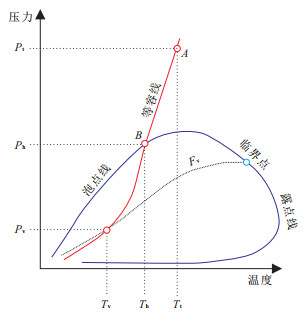
 下载:
下载:
